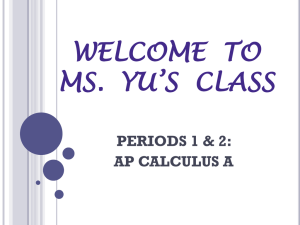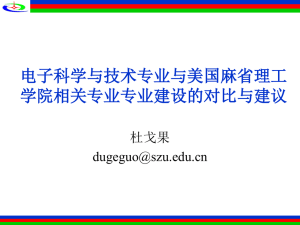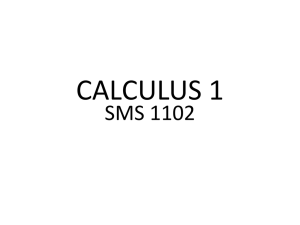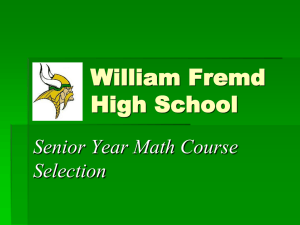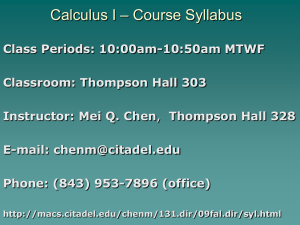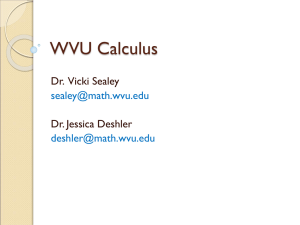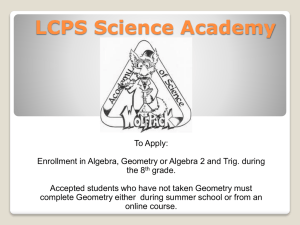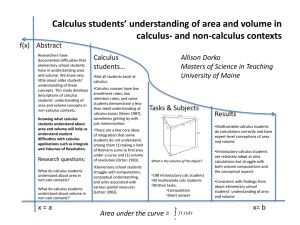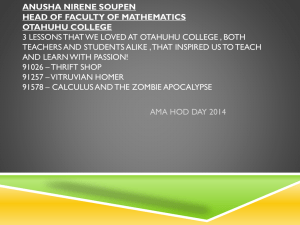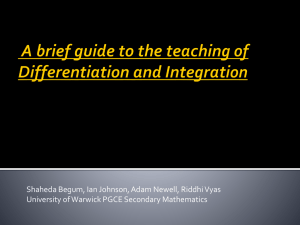STEM Math Presentation - Lansing Community College
advertisement
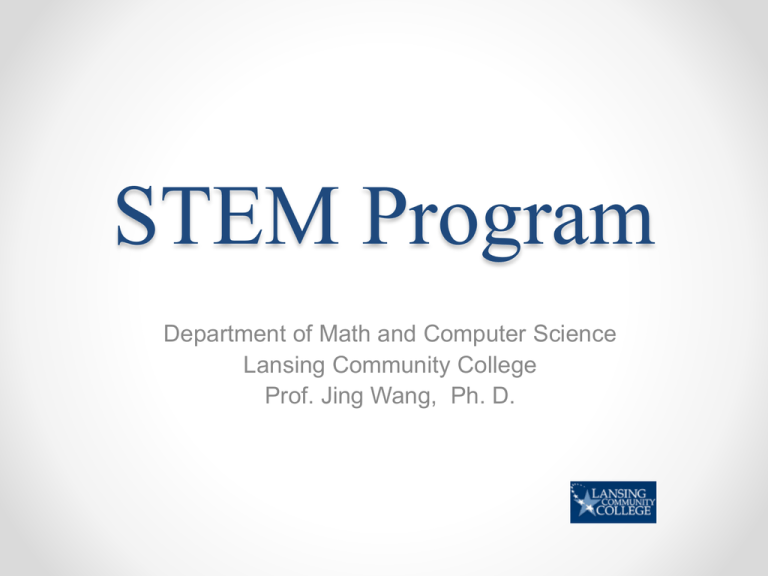
STEM Program Department of Math and Computer Science Lansing Community College Prof. Jing Wang, Ph. D. MATH after 112 MATH 121 Calculus Sequence: Computer Science Precalculus I MATH 151: Calculus I CPSC 131: MATLAB MATH 161: Honors Calculus I CPSC 230: C++ Math 152: Calculus II CPSC 231: Data Structures MATH 112 Intermediate MATH 122 Algebra Precalculus II Math 162: Honors Calculus II or High School Graduates STEM Programs MATH 126 Accelerated Precalculus Math 253: Calculus III Math 254: Diff Equation CPSC 260: Computer Science Structures Math 260: Linear Algebra Degree/Curriculum Mathematics Engineering/Physics Computer Science Math 281: Honors Seminar Calculus Projects Problems adapted from Stewart’s Calculus: Concepts and Contexts, 4e Calculus I Project: Rates of Change Purpose: Apply Differential Calculus to Authentic Problems Theme: Blood Flow in Human Body Example: Using the Law of Laminar Flow by Poiseuille: v( r ) = P R2 - r 2 ) ( 4h l www.nhlbi.nih.gov Figure from Stewart’s Calculus: Concepts and Contexts, 4e Where: v ( r ) = the velocity of the blood at the distance r from the center. We evaluate the rate of change of v with respect to r . (Also called the Velocity Gradient) Assignments · Using the flux F = kR 4 (the volume of blood per unit time that flow past a given point), Evaluate the relative change F with respect R : DF DR Result: Realizing »4 F R Interpret the real world meaning of this result. Figure from Stewart’s Calculus: Concepts and Contexts, 4e · Using the resistance of the blood, L R = C 4 (One of the Poiseuille’s Law) r Where L is the length of the blood vessel, r is the radius, C positive constant. Figure from Stewart’s Calculus: Concepts and Contexts, 4e Find the optimal branching angle (correct to nearest degree) when radius of the smaller blood vessel is two-thirds the radius of the larger vessel. Results from doing this project: Students experience how differential calculus is applied to model and solve the blood flow problems and gain a better understanding of the vascular system. They should also develop critical thinking and problem solving skills. Calculus II Project: Applying Integrals Calculus Figure from Stewart’s Calculus: Concepts and Contexts, 4e Calculus II Project: Applying Integral Calculus Calculus III Project: Modeling Tumors using Bumpy and Wrinkled Spheres Purpose: Using three dimensional calculus and graphing technique to model tumors Theme: Bumpy and Wrinkled Spheres. The members of the family of surfaces given in spherical coordinates by the equation r = a + b sin(mq )sin(nf ) have been suggested as models for tumors. www.valstarsolution.com/images/turb.jpg In this project, students will use a math software program to analyze this family of surfaces. Questions: What roles do the values m and n play in the shape of the surface? Student Work Zach Richardson Math 253 Project Fall 2012 Assignment 1 n = 10 n = 25 n=5 As n grows larger, more wedges protrude from the service of the sphere. The number of wedges appears to be equal to the value of n. Assignment 2 m=3 m=7 m = 30 The value of m seems to shift horizontal sections of the sphere alternately so that they appear “off center”. As m grows larger, there are more such shifted sections. Student Work Zach Richardson Math 253 Project Fall 2012 Assignment 3 (2,3) (8,4) (6,5) Rather than dividing the sphere vertically or horizontally, when both n and m vary the sphere becomes deformed by bumps which could be caused by the two types of wedges intersecting. The number of bumps appears to be dependent on the product of n and m so if you know their values you can predict how many bumps there will be. Assignment 4 b = .4 b = .6 b = .8 b=1 As b grows larger, the space between the bumps, the valleys, becomes more pronounced and seems to cut deeper into the sphere. Student Work Zach Richardson Math 253 Project Fall 2012 Assignment 5 a = .5 a=5 a = 50 a = 500 As a grows larger, the valleys grow less noticeable and soon appear to disappear altogether. Also, as a increases so does the radius of the sphere. When a > 5b the valleys are either gone or extremely shallow. When 5b > a the valleys become more noticeable as the difference between the two increases. Result from doing this project: Students should realize the importance of spherical coordinates. Gain experience analyzing a family of functions. Appreciate the power of computer software programs such as mathematica .

